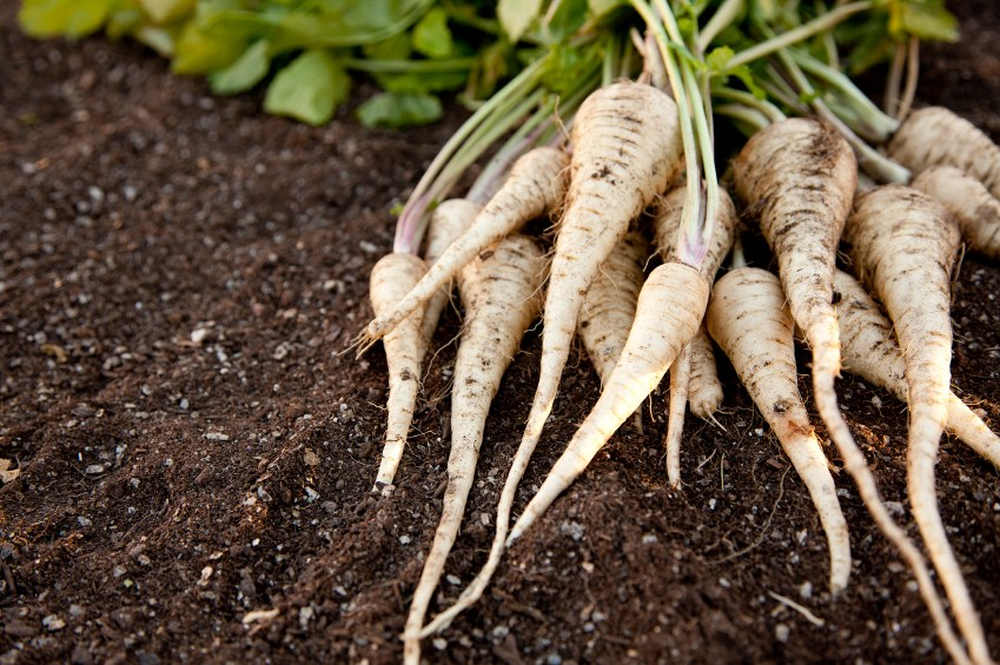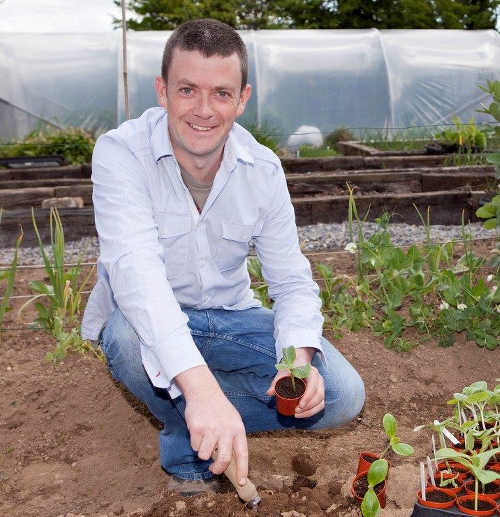Grow it Yourself - May
 Early this month I will be sowing my parsnips outside in the veg patch. Unlike carrots, they are relatively easy to grow (once you have persuaded them to germinate), and since they store well in the soil over the winter they are a valuable winter storage crop.
Early this month I will be sowing my parsnips outside in the veg patch. Unlike carrots, they are relatively easy to grow (once you have persuaded them to germinate), and since they store well in the soil over the winter they are a valuable winter storage crop.
I grow around 40 parsnips which is more than enough to keep us happy between around November (when we start hankering for root crops) and next March. To do this I need to allocate around 2m of growing space (in a standard bed you will get three rows of parsnips).
Though I practice mainly a no-dig type of growing I always put a bit of work in to the root crop bed (where carrots and parsnips will be sown) – I start by turning over the soil with a fork (to a depth of a foot) which I think is the key to a decent crop since the roots can descend in to the soil happily, with no obstructions such as hard soil or stones to thwart their growth. I then rake the soil well to even it off before sowing and break up and large clods of soil.
Most parsnip seed packets will tell you to sow them in February - don't do it. Far better to leave it until around now when germination will be more reliable thanks to warmer weather. To sow, make a drill 2cm deep – if soil is dry, dampen. Sow one seed every 5cm in rows 30cm apart and cover in with soil. Germination takes up to three weeks. When seedlings appear, thin to 10cm apart for medium sized parsnips.
Once you have sown them, there is very little maintenance needed. Weed carefully until well established and watering shouldn’t be necessary except in dry spells. Parsnips are ready to rock when the foliage starts to die away in autumn but flavour improves after first frosts. Lift them out of the soil carefully with a fork. Leave in soil until ready to eat but lift by March.
Watch a short GIY video tutorial on parsnips here: www.giyinternational.org/videos/detail/parsnips
Sowing Guide for May
I think May is often the busiest of all months in the veg patch. There’s just as much sowing to be done as there was in April, but on top of that, seeds sown in the last few months are now starting to demand more effort (hardening off, planting out etc). May is also a great catch up month, when you can still sow veg you might have forgotten about in April such as spuds and onions etc. Here’s the sowing plan for the month:
Outside direct in soil: Parsnips and peas (early May) and carrots (in late May).
Inside in module trays or pots for later transplanting: Squash, pumpkin, courgette, cucumber, leeks, cauliflower, kohlrabi, Brussels sprouts, French beans, runner beans, Florence fennel, beetroot, celery, swede.
Also this month do your regular monthly sowing of: Salad leaves, oriental greens, calabrese and annual spinach.
Recipe of the Month – Broad Bean and Dill Pilaf
If you sowed overwintering broad beans last October or November, you might well be celebrating your first broad beans of the year in the coming weeks. Serves 4.
Ingredients:
• 300g basmati rice
• 50g butter, plus extra to serve
• 1 onion, finely chopped
• 1 garlic clove, crushed
• 500ml vegetable stock
• 400g podded and skinned broad beans (about 1.6kg unpodded)
• handful dill, chopped
Directions:
Rinse the rice until the water runs clear, then soak in warm water for 5 mins and drain well. Heat the butter in a saucepan and add the onion and garlic. Sizzle everything for 8-10 mins until softened, but not coloured. Stir though the rice and pour over the stock. Cover, bring to the boil, then turn down heat to a minimum and cook the rice very slowly for 10 mins. Lift the lid, and quickly scatter over the podded beans, then replace the lid. Turn up the heat and simmer for 5 mins until all the liquid is absorbed. Add the dill, give the rice a good stir and serve with extra butter melting through.
Things to Do This Week – Pot up Courgettes
This time of the year is all about managing the timing of when you plant seedlings out in the garden. Do it too early and the plants could be knocked back. Do it too late and the plants become ‘pot-bound’ – that is, they have grown too large for their container resulting in tangling of the roots.
I grow courgettes, pumpkins and squash seeds in module trays and if I am in any way suspicious of the weather I pot them on in to bigger pots rather than planting them out in to the soil - by potting plants in to bigger pots, you buy yourself a couple of extra weeks where you can keep them in doors and get them good and sturdy.
Simply pop the seedling out of it’s module, put a little compost in the base of a bigger pot, place the seedling in carefully and then fill it in with compost. It pays to water the plants very well about an hour before hand – the seedlings pop out of the pots much easier then – and of course you need to water again after you have finished potting them on.
Join GIY
By joining GIY you help us to continue the work of supporting people just like you to grow food at home, at school, in the workplace and in the community – each year we support over 65,000 people and 1,500 community food growing groups and projects. It costs just €35 to join GIY for a year, and to say thanks we will send you a seasonal copy of our supporter’s magazine GROW and some GIY seeds for you to sow each quarter. We will also send you our weekly tips, news and advice ezine and offer you discounts to GIY events like the annual GROW Fest. Join today at www.giyireland.com.
 About GIY
About GIY
GIY is a not-for-profit organisation that aims to create a healthier, more sustainable world where people grow their own food. We inspire and support people to grow food more successfully by bringing them together to share advice, tips and ideas. There are approximately 65,000 people involved in the GIY movement in Ireland, which is proudly supported by Woodies DIY.
For more information check out www.giyireland.com
Michael Kelly is a freelance journalist, author and founder of GIY Ireland.
© GIY Ireland 2016 – all rights reserved.







There are currently no comments
Leave a comment
Not a member? Register for your free membership now!
Or leave a comment by logging in with: